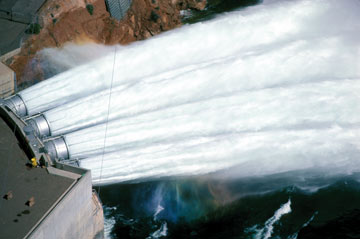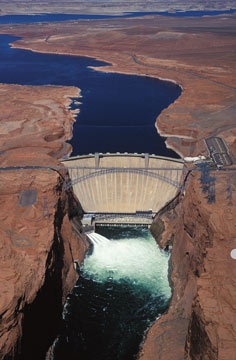 ?
? 
Global warming will show its impact not only on natural cycles of the eath but will also have severe impacts on human made sytem based on these natural processes, for example electricity generation. Increasing global temperature in the earth will effect negatively on thermal as well as hydroelectricity plants. And as we are wishing for big hydroplants in Nepal we should consider this fact. Here are some parts of one article on this topic posted on geotimes.
Balance of Power
Thomas D. Veselka
| Water spews from Glen Canyon Dam after fulfilling its hydroelectric function. |
As this story went to press, California was burning up, both literally and figuratively. Much of the state was burning in wildfires and hot temperatures were exacerbating the situation. Together, this situation is overtaxing the already-tight electric grid, with officials asking consumers to conserve power and curtail electricity use during peak demand hours. This isn’t a situation that is likely to improve in the future. Instead, this is just one example of how a warming climate could affect electricity.
Whether the global temperature increases of the past few decades are part of a natural cycle, due to anthropogenic emissions or some combination of both, it is clear that Earth and its atmosphere are constantly changing. Projections of future climate change vary substantially, both globally and regionally. And as in the past, humankind will respond to climatic and environmental changes by adapting existing systems and by creating entirely new ones.
These existing systems include one of the largest and most complex systems ever created: the electric power grid. The power grid consists of electricity-generating power plants connected by a network of wires — both high voltage transmission lines and lower voltage distribution systems — that transports electricity from generating sources to our homes, schools, factories and other places of business.
Climate affects all major aspects of the electric power sector, from electricity generation, transmission and distribution systems to consumer demand for power: If temperatures increase, people turn up their air conditioning and electricity usage spikes. If there’s less rain, there’s less water for hydropower. In myriad ways, electricity and climate are highly interconnected.
Because climate models predict that the effects of climate change will vary by region, it is likely that future impacts on the electric grid will vary by region too. Take the American West, for example. If extreme predictions of warmer temperatures and lower precipitation come to fruition in the western United States, they would significantly impact the western power grid, by overtaxing it and causing probable electricity shortages unless we build a lot of extra capacity. Such climate changes would likely have a similar effect around the world.
How weather and climate affect electricity production
Weather and climate affect all types of electrical production — everything from traditional coal-fired power plants to those that run off renewable energies such as hydroelectric power or wind — but not in the same way.
Thermal plants — which use heat from burning fossil fuels and biomass, geothermal or nuclear energy sources to produce energy — account for about two-thirds of power generated in Western Electricity Coordinating Council (WECC). At thermal power plants, electricity generation becomes less efficient as the ambient air temperature increases. As a result, more fuel is consumed to produce the same amount of electricity, raising power plant emissions. This is most pronounced with technologies that use gas turbines, accounting for about 8 percent of the generating capacity in WECC. The amount of electricity a plant can produce also decreases when temperatures rise, which ultimately may require constructing more generating units. Furthermore, changing temperatures and humidity levels alter the effectiveness of power plant cooling systems, which are utilized by technologies that use steam as a primary mover; in this way, higher temperatures and more humid air, for example, can decrease the electricity-generation capacity of a plant.
Weather and climate also affect renewable power technologies — especially hydropower. Currently, renewable technologies produce about one-third of the electricity in WECC. The vast majority, about 85 percent, comes from hydropower plants that rely on water released from reservoirs or uncontrolled stream flows as an energy source. Factors such as precipitation, snowpack levels and the timing of snowmelt affect hydropower production. Moreover, humidity levels and wind speed impact water loss in reservoirs due to evaporation. The seasonal timing of precipitation and weather events significantly influences hydropower economics and the operation of the entire power system.
Electricity generated from hydropower plants has the highest value when the demand for power is the greatest. In most of the West, this typically occurs during the warmest summer months. But a warmer climate might mean earlier snowmelt, which could reduce the value of hydropower resources. Some of the negative impacts of early snowmelt can be mitigated through reservoir management, but there is a limit to the amount of water that can be stored. And hydropower plants that rely on river flows instead of reservoirs cannot store any water, so generation is dictated entirely by streamflow rates.
|
Glen Canyon Dam is one of the largest concrete dams in the world.
|
Other renewable technologies are also affected by weather and climate. Solar technologies, for example, are affected by cloud cover and the amount of solar radiation that reaches the ground. Wind power production can change drastically if wind conditions change. If the wind is too slow, power generation ceases. If the wind is too fast, wind turbines must be turned off to protect the equipment from mechanical and electrical stress. No one can predict what wind changes might occur with climate change, but it is important to note that any changes do affect the system.
Electricity generation is not the only facet of the electric grid system that is affected. Higher air temperatures exacerbate thermal expansion of power transmission and distribution lines, which cause lines to sag: Go outside on a hot summer day and you’ll notice that the electrical lines sag more than they do on a cooler day. That line sagging decreases the amount of power that can be securely transported. Other factors, such as wind speed and direction, also affect transmission line cooling. Under high load periods, the reduced capability of transmission lines increases congestion problems in some regions, potentially causing everything from utilizing units that have high operating costs more frequently to higher incidences of rolling blackouts.
http://www.geotimes.org/aug08/article.html?id=feature_electricity.html


